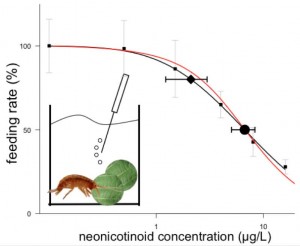In this post, PhD student Dominic Englert shares his poster „Are neonicotinoids a threat for leaf litter breakdown? A laboratory approach with leaf shredding invertebrates“ that he presented during this year’s SETAC Europe Meeting.
“In this study, two key leaf-shredding invertebrates (i.e., the amphipod Gammarus fossarum and the insect larvae Chaetopteryx villosa) were exposed to three different neonicotinoid insecticides (i.e., thiacloprid, imidacloprid and acetamiprid) separately and in a mixture containing all three compounds to assess for potential risks in the ecosystem process of leaf litter breakdown. Although neonicotinoids are designed to act specifically against insect pests, the amphipod G. fossarum was, unexpectedly, up to 5 times more sensitive (based on determined effect concentrations causing a 20% reduction in feeding) towards neonicotinoids than the insect larvae C. villosa. Moreover, the measured feeding rate of G. fossarum exposed to the neonicotinoid mixture agreed well with the expectations based on a concentration addition model, displaying the additive action of different neonicotinoid compounds.
For more info, see our poster, which can be downloaded via the link below:

